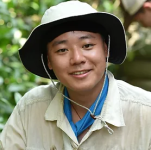

Leo Chiu-Leung
leo.chiuleung@my.jcu.edu.au
Recipient of an AIMS@JCU Scholarship
PhD
College of Science and Engineering

Leo Chiu-Leung
leo.chiuleung@my.jcu.edu.au
PhD
College of Science and Engineering
The soundscapes of the Great Barrier Reef in the face of a changing climate
Mr. Leo Chiu-Leung is a certified PADI Dive Master with Emergency First Response Certifications. Other diver specialties include Deep Diver, Night Diver, NITROX, In-water Fish Identification, and Coral Reef.
He has been involved in several ecological survey projects in Hong Kong, Malaysia, and the Philippines, with his most recent work involving the isotopic mapping of Hong Kong seashore ecosystems. His previous work includes installation and replacement of various underwater sensors, as well as analysis of data from Passive Acoustic Monitoring (PAM) SoundTraps and Acoustic Doppler Current Profilers (ADCP) within Hong Kong.
Other projects that he has been involved in include, the writing of a 10-year developmental plan of a mangrove forest in Malaysia and the investigation of its local fish population, and gathering and analyzing data of fish blasting and associated reef ecosystem health as part of anti-fish blasting efforts under Reef Defenders.
His previous study topics include examining of reefal fish populations within Hong Kong, comparing the different vocalizations of freshwater fish at Whivenhoe Dam, Australia, and comparing the soundscapes of Lizard Island, Australia patch reefs with and without cleaner wrasse.
His professional interests include Marine sound ecology, Tropical to sub-tropical Inshore Ecology, Ichthyology, and Reef Conservation.
The soundscapes of the Great Barrier Reef in the face of a changing climate
2024 to 2028
Project Description
The waters of the Great Barrier Reef (GBR) are full of a diverse range of biological sounds that can provide information on species composition, distribution, abundance, and behaviour. The study of the contribution of these sounds to the overall soundscape (‘ecoacoustics’) is a novel tool and cost effective for aquatic monitoring, providing a complementary metric to characterise local ecosystem condition. These soundscapes influence behaviour of reef organisms at key moments in their life (e.g., habitat selection, mate choice, predator avoidance), but habitat degradation and loss, and noise pollution disrupts behaviour. As the GBR and its residents adapt their health, behaviour and distribution to cope with increasing pressures from climate change and anthropogenic activities (e.g., fishing, boat noise, offshore development), so too do the associated soundscapes. Benchmark studies have already begun documenting soundscapes and post-climate event changes at local scales, but appropriate representation of the entire region is needed. This project will, for the first time, collect, collate and compare coral reef soundscapes from the length and breadth of the GBR. These recordings would be co-located with key ‘validation’ data (e.g., fish and coral composition) allowing variation in soundscapes at different spatial scales to be related to key ecological information.
Project Importance
Aquatic ecoacoustics is a growing field of research with i) limited understanding and field validation of the relationship between acoustic and ecological biodiversity, and ii) significant area for growth in the development of automated and artificial intelligence analyses. As this technique offers a remote, autonomous, non-interactive datastream on reef health, it offers a potentially cost-effective means of evaluating the status and condition reef habitats over long temporal scales. This has many advantages over current diver-based approaches that are labour intensive, require considerable expertise, and only provide a snapshot (i.e., single point in time) of ecological communities
The combined ecoacoustic and co-located observational and physical data (fish and coral surveys conducted by the AIMS programs), will allow the project to provide i) a characterised baseline of the soundscapes of reefs of the GBR at multiple spatial scales, ii) improved understanding of how the soundscapes relate to local ecosystem condition, iii) improved understanding of how different marine fauna respond to sound and ultimately iv) further develop a technology to monitor GBR health, resilience and the success of restoration efforts.
Project Methods
Passive acoustic monitoring (PAM) data is collected via the deployment of hydrophone sensors with logging systems, here, OceanInstruments SoundTraps (ST300s and ST600s). These will be deployed to various sites along and across the GBR, corresponding with areas of existing AIMS monitoring and ecological data. The soundtraps will be predominantly deployed to sites where co-located environmental (e.g., temperature) and community (e.g., fish species composition and abundance, coral cover, species and complexity, eDNA) data exists.
These deployments will be collected in line with multiple AIMS programs to achieve data acquisition from sites including the far north, north, central and southern GBR (e.g., AIMS’s Reef Song program – Lizard Island, Woppaburra Coral Project – Keppel Island Group, Reefworks – Davies Reef, EcoRAP – Moore Reef). The number and frequency of deployments over the next three years is to be determined, but with >70 long-term monitoring sites and multiple additional monitoring/research programs conducted by AIMS, field access to collect data is considered a low risk.
PAM data will be analysed with multiple standard software packages and purpose-written functions to assess sound pressure levels (broadband and specific frequency bands), ecoacoustic indices (e.g., acoustic complexity index, acoustic richness) and event detection (e.g., number and types of fish calls and invertebrates sounds) to characterise the soundscape. The soundscapes will be compared to complementary data on the fish, invertebrate and coral communities and relationships teased out through a variety of appropriate statistical models once the data has undergone preliminary exploration (e.g., ANOVAs, GAMS, GMMS etc).
Individual sounds will be extracted from recordings using purpose-written Matlab programs and Cornell University’s Raven software. These recordings will be matched, where possible, to source species to develop a library of underwater biological sounds for the GBR, in conjunction with the Global Library of Underwater Biological Sounds.
Project Results
It is hoped that the project will be able to map geographic, temporal, and climate change based differences in the soundscape of the great barrier reef.
Keywords
Benthic,
Climate change,
Coral reefs,
Corals,
Crustaceans,
Ecology,
Field based,
Fish,
Management tools,
Monitoring,
Natural disturbance,
Remote Sensing